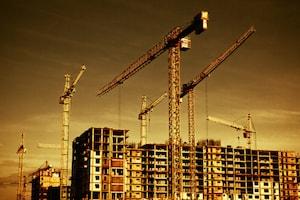Crane Accidents

Cranes are often the largest equipment on construction sites and pose significant safety risks for both operators and other construction workers. The Crane Inspection & Certification Bureau (CICB) reports that crane injuries are on the rise, and often are the direct result of negligence of the operator. Citing various authorities including the Bureau of Labor Statistics, CICB reports the following figures related to crane injuries:
- 90% of crane accidents occur due to human error
- 80% of all crane upsets are attributed to operators exceeding the crane’s operational capacity
- 54% of these incidents are the result of swinging the boom or making a lift without the outriggers fully extended
- 45% of all mobile crane accidents involve electrocution that results from the crane contacting a power source during operation
- 40% the victims were struck by an object (such as an uncontrolled hoisted load or crane part)
- 50% of U.S. crane accidents that had injuries in 2009 resulted in fatalities
- 80 lift and material handling equipment workers are killed each year, on average
Considering that half of workers hurt in crane accidents die, crane safety must be taken seriously. It is imperative that all present on construction sites do what it takes to protect workers from injury and death, as all workers are at risk for a crane injury, whether or not they are involved in crane work. The Center for Construction Research and Training conducted an extensive analysis of crane deaths from 1992-2006 and found, among other things, that about one third of the workers killed in crane incidents were not involved in crane work. Electrocution is the most common cause of death in crane related incidents (boom contacting power lines, etc.), followed by workers being struck by a crane load, crane collapse, and workers struck by a falling boom/jib. Sadly, all of these types of incidents are preventable simply by following industry safety standards.
Washington has enacted safety regulations specific to cranes, rigging, and personnel work under the Washington Industrial Safety and Health Act (WISHA). See WAC 296-155-529 through WAC 296-155-56430. There are over 100 crane-specific regulations that must be followed on constructions sites, and violation of any of these regulations constitutes negligence. A worker injured due to the failure to follow these regulations may be entitled to financial recovery for those injuries. Some key requirements for crane work under WISHA are:
- All cranes covered by the regulation must be certified and proof load tested annually by an accredited crane certifier (WAC 296-155-52901)
- Crane operators must be certified, and there are graduated requirements for how many hours of crane experience operators must have before operating various types of cranes (WAC 296-155-53300)
- Other crane workers such as the signal person, repair and maintenance workers, and riggers, must meet specific qualifications (WAC 296-155-53302 through WAC 296-155-53306)
- The operator’s cab must be equipped with an operator’s manual, load rating chart, other information related to “rated capacity”, a work area chart indicating areas where no load it to be handled, and other detailed site specific information
- A competent person must inspect cranes and components daily when used, and periodically during use to make sure it is in safe operating condition
- The operator must not engage in any activity that diverts his/her attention while operating the crane, such as cell phone use, and may not leave the controls while a load is suspended
- Where available, hoisting routes that minimize the exposure of employees to hoisted loads must be used to the extent consistent with public safety and while the operator is not moving a suspended load, employees must be kept out of the fall zone
Despite detailed safety requirements, crane accidents continue to cause injuries and death on construction sites due to unsafe practices and/or a failure to follow the requirements for crane work under WISHA. If you were injured in a crane accident, the lawyers at Kraft Davies Olsson PLLC, are available to help you get to the bottom of what caused the accident, and find out whether you are entitled to financial recovery for your injuries. Call today for a free consultation.







